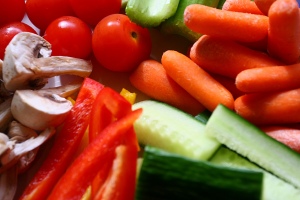
via Flickr
I’m in love with avocados, they taste amazing, they’re versatile, they’re packed full of vitamins, protein and good fats, but when I cut open the fruit I eat about half since it also is a lot of calories. However, when I used to throw the other half of the avocado in the fridge, it would quickly begin to brown. What I learned from all of my avocado eating is that there are also ways of storing fruits and veggies so that they last longer.
What you initially need to know is that some fruits give off ethylene gas which makes a lot of vegetables ripen and spoil too quickly. That whole, “one bad apple will spoil the whole bunch,” is kind of true unless you know how to store your produce. When you do store perishable fresh fruits and vegetables, such as strawberries, lettuce, herbs, and mushrooms, do so in a clean refrigerator at a temperature of 40° F or below. Any and all produce that is purchased pre-cut or peeled also need to be refrigerated. When you do cut produce with skin such as apples, avocados and potatoes whose insides brown quickly, lightly brushing lemon juice on the exposed area to keep their color longer.
What You Need To Refrigerate:
Fruit
Apples– Apples are ethylene gas producers so store away from other produce in a cool, dark place or in the refrigerator in a plastic bag with holes.
Melons– Store cantaloupe and honeydew loose in the refrigerator, even before they’re cut. Watermelon can be kept in a dark, dry place away from other produce. Keep cut melon in the fridge.
Berries– Blueberries, blackberries, strawberries and raspberries are delicate and should not be washed until ready to eat. Keep in refrigerator in dry, covered containers.
Cherries & Grapes– Store in refrigerator, unwashed, in their packaged plastic containers orplastic bags until ready to eat.
Citrus fruit– Extend the shelf life of clementines, grapefruit, lemons, limes and oranges by storing them in the crisper drawer or in a mesh bag in the refrigerator.
Vegetables
Celery– Keep loose in refrigerator drawer in a sealed plastic bag or container.
Corn– Store in the refrigerator inside their husks.
Cucumbers– Keep in the refrigerator away from other produce on the upper shelf (the “warmer” part of the fridge.)
Broccoli & Cauliflower– Broccoli and cauliflower are best kept in separate refrigerator drawers away from other produce.
Eggplant– Place in bag with holes and store on middle or upper refrigerator shelf.
Green beans– Store in a sealed container or bag in refrigerator.
Leafy green vegetables– Greens like lettuce, collards, chard, kale, and spinach should be washed and dried, wrapped loosely in a dishtowel or paper towels and placed in a plastic bag in a refrigerator drawer, but I skip the washing until I’m absolutely going to eat it right away.
Mushrooms– Keep unwashed in a paper bag in the refrigerator. Moisture makes them slimy.
Peppers– Store sweet and hot peppers in a plastic bag on the upper shelf of refrigerator.
Root vegetables– Remove green tops of carrots and parsnips, then store in a plastic bag with holes in the crisper drawer. Beets and turnips can be kept loose in the crisper after removing their green tops.
Yellow Squash & Zucchini– Store in plastic bags in the refrigerator.
What You Should Not To Refrigerate:
Avocados– Store in a paper bag on the counter until ripe.
Bananas, unripe– Keep green bananas out of the refrigerator but away from other foods – they’ll ripen nicely in a bowl. (If you want a hard piece of fruit like an avocado, peach, pear or plum to ripen quickly, place it in a paper bag with a banana)
Stone fruit– Keep apricots, nectarines, peaches and plums in a paper bag on the counter until they are ripe then move to the refrigerator where they’ll last a few more days.
Tomatoes– Always store at room temperature as the refrigerator will make them rot quickly. Keep loose in a bowl away from sun or heat (like the stove.)
Onion family– Store garlic, onions and shallots in a cool, dark and dry space but separate from other foods because of their strong odors.
Potatoes– Store potatoes, sweet potatoes and yams in a cool, dark and dry place like a pantry or cellar.
For more tips and vegetarian recipes don’t forget to check out my book, “The Beginners Guide to Becoming a Vegetarian,” on Amazon.
This is really informative, thanks! To my lasting dismay, I just found out that I’m allergic to avocados 😦
LikeLike
😦
LikeLike